Imagine launching your startup with an eye-catching logo, only to discover months later that another company is using a nearly identical design. Not only can this lead to brand confusion, but it could also result in legal battles that drain your resources. This scenario highlights the importance of securing logo protection through trademarking. Your startup branding is one of your most valuable assets, and without proper legal safeguards, you risk losing the exclusive rights to your own identity.
Trademarking your startup’s logo ensures that only you have the legal right to use it in commerce, helping to build trust with customers while safeguarding your brand from imitators. In this guide, we’ll walk you through the trademark process step by step so you can confidently protect your brand.
What Is a Trademark and Why It Matters for Startups
A trademark is a legally registered symbol, word, or phrase that distinguishes your brand from competitors. In the case of a logo, it serves as a visual identifier that represents your startup. Without trademark protection, your logo could be copied by others, leading to confusion and potential loss of customers.
For startups, trademarks are crucial because they:
- Ensure Exclusivity: Prevent others from using a similar design that could mislead customers.
- Strengthen Brand Recognition: A unique logo helps customers identify and remember your business.
- Provide Legal Protection: Grants the owner the right to take legal action against infringers.
- Increase Business Value: A registered trademark adds credibility and can be an asset if you plan to sell or franchise your business.
In a competitive market, protecting your intellectual property for startups is essential for long-term success. Registering a trademark gives you a legal foundation for enforcing your rights and preventing costly disputes.
Step-by-Step Guide to Trademark Your Startup’s Logo
1. Conduct a Trademark Search
Before applying for a trademark, research existing trademarks to ensure your logo is unique. The U.S. Patent and Trademark Office (USPTO) database is a great starting point. Hiring a trademark attorney or using online search tools can help uncover any potential conflicts that may not be obvious.
2. Design a Distinctive Logo
The more unique your logo, the easier it is to secure a trademark. Avoid generic symbols, overused fonts, or simple geometric shapes that could be deemed too common. A strong, original design increases your chances of approval.
3. Choose the Right Trademark Class
Trademarks are categorized into different classes based on the type of goods or services they represent. Make sure to select the appropriate class for your industry. Choosing the wrong class can delay your application or limit your trademark protection.
4. Prepare and File Your Application
To file for a trademark in the U.S., submit an application through the USPTO. You’ll need to provide:
- A high-quality image of your logo
- Business name and owner details
- A description of goods and services
- The correct trademark class
- Filing fee (typically $350-$550 per class)
If you’re operating internationally, consider filing through the World Intellectual Property Organization (WIPO) for broader protection.
5. Respond to Office Actions
After submitting your application, the USPTO will review it. If there are any issues, you may receive an Office Action, which outlines objections or required modifications. Address these promptly to avoid delays or rejection.
6. Publication and Opposition Period
If your application is approved, it will be published for opposition. This allows third parties to challenge your trademark if they believe it conflicts with theirs. If no objections are raised, your registration moves to the final approval stage.
7. Trademark Registration and Maintenance
Once approved, your trademark will be officially registered. However, protection doesn’t end there. You must:
- Use the trademark in commerce regularly.
- File maintenance documents every 5-10 years.
- Monitor for potential infringements and take legal action if necessary.
Failing to maintain your trademark could result in its cancellation, leaving your brand vulnerable.
Costs, Timelines, and Maintenance
Trademarking a logo typically costs between $350 to $550 per class if you file independently. Hiring a trademark attorney may add $1,000 to $2,500 in fees but can improve your chances of approval. The entire trademark process can take anywhere from 6 months to over a year, depending on USPTO processing times and potential objections.
Once registered, your trademark remains valid as long as you actively use it in commerce and file renewal documents on time. Monitoring your trademark is also essential to prevent unauthorized use by competitors.
Conclusion
Securing logo protection through a trademark is a vital step in building and maintaining your startup’s identity. A registered trademark ensures you have exclusive rights to your logo, prevents competitors from copying it, and strengthens your brand value.
If you haven’t yet trademarked your startup’s logo, now is the time to take action. Whether you handle the process yourself or hire an attorney, protecting your intellectual property for startups is an investment that safeguards your business for the future.
Ready to secure your brand? Start the trademark process today to protect your startup’s logo from unauthorized use and build a strong foundation for your business!

